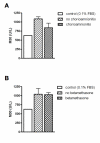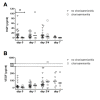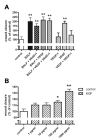Bronchoalveolar lavage fluid from preterm infants with chorioamnionitis inhibits alveolar epithelial repair
- PMID: 19930634
- PMCID: PMC2784455
- DOI: 10.1186/1465-9921-10-116
Bronchoalveolar lavage fluid from preterm infants with chorioamnionitis inhibits alveolar epithelial repair
Abstract
Background: Preterm infants are highly susceptible to lung injury. While both chorioamnionitis and antenatal steroids induce lung maturation, chorioamnionitis is also associated with adverse lung development. We investigated the ability of bronchoalveolar lavage fluid (BALF) from ventilated preterm infants to restore alveolar epithelial integrity after injury in vitro, depending on whether or not they were exposed to chorioamnionitis or antenatal steroids. For this purpose, a translational model for alveolar epithelial repair was developed and characterised.
Methods: BALF was added to mechanically wounded monolayers of A549 cells. Wound closure was quantified over time and compared between preterm infants (gestational age < 32 wks) exposed or not exposed to chorioamnionitis and antenatal steroids (>or= 1 dose). Furthermore, keratinocyte growth factor (KGF) and vascular endothelial growth factor (VEGF) were quantified in BALF, and their ability to induce alveolar epithelial repair was evaluated in the model.
Results: On day 0/1, BALF from infants exposed to antenatal steroids significantly increased epithelial repair (40.3 +/- 35.5 vs. -6.3 +/- 75.0% above control/mg protein), while chorioamnionitis decreased wound-healing capacity of BALF (-2.9 +/- 87.1 vs. 40.2 +/- 36.9% above control/mg protein). BALF from patients with chorioamnionitis contained less KGF (11 (0-27) vs. 0 (0-4) pg/ml) and less detectable VEGF (66 vs. 95%) on day 0. BALF levels of VEGF and KGF correlated with its ability to induce wound repair. Moreover, KGF stimulated epithelial repair dose-dependently, although the low levels in BALF suggest KGF is not a major modulator of BALF-induced wound repair. VEGF also stimulated alveolar epithelial repair, an effect that was blocked by addition of soluble VEGF receptor-1 (sVEGFr1/Flt-1). However, BALF-induced wound repair was not significantly affected by addition of sVEGFr1.
Conclusion: Antenatal steroids improve the ability of BALF derived from preterm infants to stimulate alveolar epithelial repair in vitro. Conversely, chorioamnionitis is associated with decreased wound-healing capacity of BALF. A definite role for KGF and VEGF in either process could not be established. Decreased ability to induce alveolar epithelial repair after injury may contribute to the association between chorioamnionitis and adverse lung development in mechanically ventilated preterm infants.
Figures





Similar articles
-
Keratinocyte growth factor promotes epithelial survival and resolution in a human model of lung injury.Am J Respir Crit Care Med. 2014 Jun 15;189(12):1520-9. doi: 10.1164/rccm.201310-1892OC. Am J Respir Crit Care Med. 2014. PMID: 24716610 Free PMC article. Clinical Trial.
-
Pulmonary effects of keratinocyte growth factor in newborn rats exposed to hyperoxia.Am J Physiol Lung Cell Mol Physiol. 2009 Nov;297(5):L965-76. doi: 10.1152/ajplung.00136.2009. Epub 2009 Aug 21. Am J Physiol Lung Cell Mol Physiol. 2009. PMID: 19700645
-
Increased prevalence of low oligomeric state surfactant protein D with restricted lectin activity in bronchoalveolar lavage fluid from preterm infants.Thorax. 2013 May;68(5):460-7. doi: 10.1136/thoraxjnl-2012-202729. Epub 2013 Feb 6. Thorax. 2013. PMID: 23390139
-
Mechanisms of alveolar epithelial repair in acute lung injury--a translational approach.Swiss Med Wkly. 2003 Nov 22;133(43-44):586-90. doi: 10.4414/smw.2003.10267. Swiss Med Wkly. 2003. PMID: 14745653 Review.
-
Inhalation or instillation of steroids for the prevention of bronchopulmonary dysplasia.Neonatology. 2015;107(4):358-9. doi: 10.1159/000381132. Epub 2015 Jun 5. Neonatology. 2015. PMID: 26044104 Review.
Cited by
-
Anti-sFlt-1 Therapy Preserves Lung Alveolar and Vascular Growth in Antenatal Models of Bronchopulmonary Dysplasia.Am J Respir Crit Care Med. 2018 Mar 15;197(6):776-787. doi: 10.1164/rccm.201707-1371OC. Am J Respir Crit Care Med. 2018. PMID: 29268623 Free PMC article.
-
Prenatal Immunity and Influences on Necrotizing Enterocolitis and Associated Neonatal Disorders.Front Immunol. 2021 Apr 21;12:650709. doi: 10.3389/fimmu.2021.650709. eCollection 2021. Front Immunol. 2021. PMID: 33968047 Free PMC article. Review.
-
Viral Induced Effects on a Vulnerable Epithelium; Lessons Learned From Paediatric Asthma and Eosinophilic Oesophagitis.Front Immunol. 2021 Nov 29;12:773600. doi: 10.3389/fimmu.2021.773600. eCollection 2021. Front Immunol. 2021. PMID: 34912343 Free PMC article. Review.
-
Preterm ovine respiratory epithelial cell responses to mechanical ventilation, lipopolysaccharide, and interleukin-13.Am J Physiol Lung Cell Mol Physiol. 2023 Jun 1;324(6):L815-L824. doi: 10.1152/ajplung.00355.2022. Epub 2023 Apr 25. Am J Physiol Lung Cell Mol Physiol. 2023. PMID: 37096911 Free PMC article.
-
The role of vascular endothelial growth factor receptor-1 signaling in compensatory contralateral lung growth following unilateral pneumonectomy.Lab Invest. 2015 May;95(5):456-68. doi: 10.1038/labinvest.2014.159. Epub 2015 Feb 2. Lab Invest. 2015. PMID: 25642830
References
-
- Roberts D, Dalziel S. Antenatal corticosteroids for accelerating fetal lung maturation for women at risk of preterm birth. Cochrane Database Syst Rev. 2006;3:CD004454. - PubMed
Publication types
MeSH terms
Substances
LinkOut - more resources
Full Text Sources

